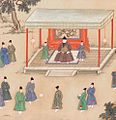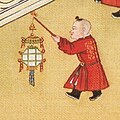Yesa robe

Yesa robe (Chinese: 曳撒袍; pinyin: Yèsāpáo), also known simply referred as Yesa (Chinese: 曳撒), Yisan (Chinese: 曳撒), or Yisa (Chinese: 一撒), is an ancient type of Chinese clothing worn during the Ming dynasty.[1][2] It was originated in the Ming dynasty but was influenced from clothing of the Yuan dynasty; it was initially worn in the palace and by the wealthy, and it later spread to the commoners.[1]
History[]
Origins[]
During the Ming dynasty, some clothing incorporated the clothing elements from the Han Chinese and the Mongol clothing tradition; one of those mixed-elements is the yesa.[3] The clothing known as yesa originated in the Ming dynasty, but some of its elements were either adopted from the Yuan dynasty Mongol's terlig,[1] or directly from the Mongol's jisün clothing which is also a form of terlig.[3] The yesa is itself a new evolution of terlig.[4]
Ming dynasty[]
The yesa robe is a form of kuzhe (Chinese: 袴褶; clothing with trousers for riding or military style clothing); however, the design of the yesa made it no more functional for horse riding.[4][5]
The yesa was worn as an informal attire by emperors, princes, ministers, and officials in their spare time during the early period of the Ming dynasty; it was worn as a formal uniforms in some occasions during the middle period of the Ming dynasty; it was worn as a casual dress worn by scholar-officials during the mid-to-late period of the Ming dynasty; and eventually it was worn by servants and commoners in the late Ming.[1]
The Ming court eunuchs wore yesa robe in different styles, such as the red-coloured yesa robes with a qilin patch, round-collared yesa robes, and light green yesa robe, etc.[1]
Construction and Design[]
The yesa robe is a cross-collared, long sleeved robe with narrow pleats on the lower hem; while the back of the lower part is flat, the front had two densely pleated sides with a flat middle.[1][4] It has two hems at each sides.[1][4] The sleeves and the bodice were wider compared to the Mongol Yuan's terlig and it had no waistband; the skirt was also longer.[4]
Gallery[]

Jinyiwei Ming Dynasty.



See also[]
References[]
- ^ a b c d e f g Wei, Luo (2018-01-02). "A Preliminary Study of Mongol Costumes in the Ming Dynasty". Social Sciences in China. 39 (1): 165–185. doi:10.1080/02529203.2018.1414417. ISSN 0252-9203. S2CID 149138176.
- ^ "Ancient Chinese Robes for Men: Tieli & Yisan - 2020". www.newhanfu.com. 2020. Retrieved 2021-05-05.
- ^ a b Wang, Guojun (2020). Staging personhood : costuming in early Qing drama. New York. ISBN 978-0-231-54957-8. OCLC 1129398697.
- ^ a b c d e Cho, Woohyun; Yi, Jaeyoon; Kim, Jinyoung (2015). "The dress of the Mongol Empire: Genealogy and diaspora of theTerlig". Acta Orientalia Academiae Scientiarum Hungaricae. 68 (3): 22–29. doi:10.1556/062.2015.68.3.2. ISSN 0001-6446.
- ^ Finnane, Antonia (2008). Changing clothes in China : fashion, history, nation. New York: Columbia University Press. p. 45. ISBN 978-0-231-14350-9. OCLC 84903948.
- Clothing stubs
- China stubs
- Chinese traditional clothing



